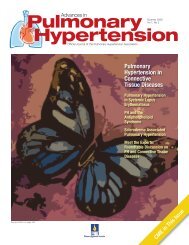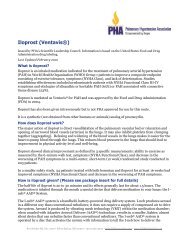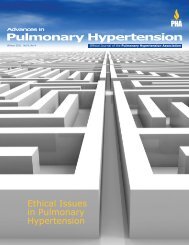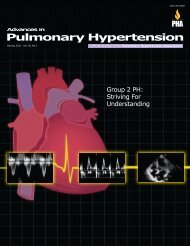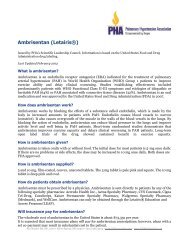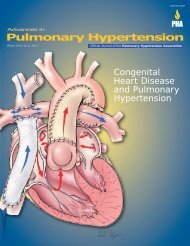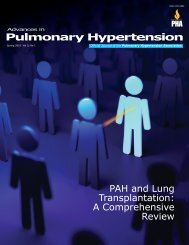Vol 7, No 3 - PHA Online University
Vol 7, No 3 - PHA Online University
Vol 7, No 3 - PHA Online University
You also want an ePaper? Increase the reach of your titles
YUMPU automatically turns print PDFs into web optimized ePapers that Google loves.
In the treatment of pulmonary arterial hypertension (PAH)<br />
(WHO Group 1, Class II or III symptoms)<br />
Living with PAH<br />
can be complicated...<br />
Choosing a therapy<br />
should not be.<br />
Please see below for important safety information, including<br />
boxed WARNINGS on the possible risk of liver injury and the<br />
risk of serious birth defects.<br />
INDICATION: LETAIRIS is an endothelin receptor antagonist indicated for<br />
the treatment of pulmonary arterial hypertension (PAH) (WHO Group 1)<br />
in patients with WHO Class II or III symptoms to improve exercise capacity<br />
and delay clinical worsening.<br />
Clinical worsening is defined as the first occurrence of death, lung<br />
transplantation, hospitalization for PAH, atrial septostomy, study<br />
withdrawal due to the addition of other PAH therapeutic agents, or study<br />
withdrawal due to early escape. 1<br />
Early escape criteria were two or more of the following after a<br />
minimum treatment period of 4 weeks: ≥20% decrease in 6-minute walk<br />
distance; worsening WHO functional class; worsening right ventricular<br />
failure; rapidly progressing cardiac, hepatic, or renal failure; and refractory<br />
systolic hypotension 5× ULN or if elevations are accompanied by bilirubin >2× ULN<br />
or by signs or symptoms of liver dysfunction<br />
• May cause fetal harm if taken during pregnancy<br />
• Must exclude pregnancy before the start of treatment<br />
• Prevent pregnancy thereafter by the use of two reliable methods<br />
of contraception<br />
Important safety information regarding hepatotoxicity<br />
LETAIRIS is not recommended in patients with elevated aminotransferases<br />
(>3× ULN) at baseline because monitoring liver injury may be more difficult.<br />
If aminotransferase elevations are accompanied by clinical symptoms of<br />
liver injury (such as anorexia, nausea, vomiting, fever, malaise, fatigue, right<br />
upper quadrant abdominal discomfort, itching, or jaundice) or increases in<br />
bilirubin >2× ULN, LETAIRIS treatment should be stopped. There is no<br />
experience with the reintroduction of LETAIRIS in these circumstances.<br />
Contraindication<br />
• Do not administer LETAIRIS to a pregnant woman because it can cause<br />
fetal harm<br />
Warnings and precautions<br />
• Decreases in hemoglobin have been observed within the first few weeks<br />
of treatment with LETAIRIS; measure hemoglobin prior to initiation, at<br />
1 month, and periodically thereafter<br />
• Mild to moderate peripheral edema. Peripheral edema occurred more<br />
frequently in elderly patients (age ≥65 years) receiving LETAIRIS (29%;<br />
16/56) compared to placebo (4%; 1/28)<br />
• Peripheral edema is a known class effect of endothelin receptor<br />
antagonists. In addition, there have been postmarketing reports of fluid<br />
retention occurring within weeks after starting LETAIRIS which required<br />
intervention with a diuretic, fluid management, or, in some cases,<br />
hospitalization for decompensating heart failure<br />
Drug interactions<br />
• Use caution when LETAIRIS is coadministered with cyclosporine A<br />
• Use caution when LETAIRIS is coadministered with strong CYP3A<br />
inhibitors (e.g., ketoconazole) or CYP2C19 inhibitors (e.g., omeprazole)<br />
• Use caution when LETAIRIS is coadministered with inducers of P-gp,<br />
CYPs, and UGTs



